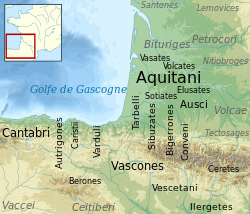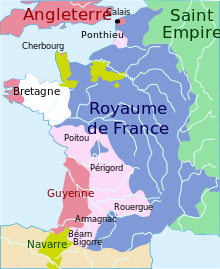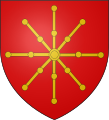مملكة نڤاره
Kingdom of Navarre | |||||||||||
|---|---|---|---|---|---|---|---|---|---|---|---|
| 824 (traditional)–1841 | |||||||||||
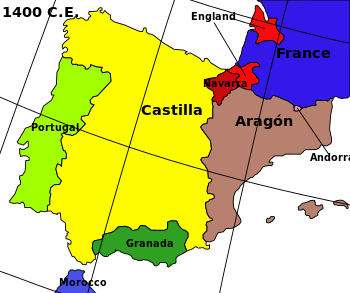 Navarre's boundaries in the year 1400
Navarre | |||||||||||
| العاصمة | Pamplona (باسكية: Iruñea) | ||||||||||
| اللغات المشتركة | |||||||||||
| الدين | Majority religion:
Minority religions:
| ||||||||||
| الحكومة | Feudal monarchy | ||||||||||
| Monarch | |||||||||||
• 824–851/2 | Íñigo Arista (first) | ||||||||||
• 1610–1620 | Louis II (last. French kingdom) | ||||||||||
• 1830–1841 | Isabel II of Spain (last. Spanish kingdom) | ||||||||||
| الحقبة التاريخية | Middle Ages | ||||||||||
• تأسست | 824 (traditional) | ||||||||||
• انحلت | 1841 | ||||||||||
| المساحة | |||||||||||
| 1300[7] | 10،000 km2 (3،900 sq mi) | ||||||||||
| التعداد | |||||||||||
• 1300[7] | 100 000 | ||||||||||
| |||||||||||
| اليوم جزء من | Spain France | ||||||||||
مملكة نـَڤارِّه (باسكية: Nafarroako Erresuma, إسپانية: Reino de Navarra, فرنسية: Royaume de Navarre, لاتينية: Regnum Navarrae؛ إنگليزية: Kingdom of Navarre؛ /nəˈvɑːr/) في الأصل مملكة پمپلونة (باسكية: Iruñeko Erresuma) كانت مملكة باسكية في الأراضي على جانبي جبال الپرانس الغربية إلى جانب المحيط الأطلسي بين اسبانيا الحالية]] وفرنسا.[8][9][10]
The medieval state took form around the city of Pamplona during the first centuries of the Iberian Reconquista. The kingdom has its origins in the conflict in the buffer region between the Frankish king Charlemagne and the Umayyad Emirate that controlled most of the Iberian Peninsula. The city of Pamplona (لاتينية: Pompaelo; باسكية: Iruñea), had been the main city of the indigenous Vasconic population and was located amid a predominantly Basque-speaking area.[11][12] In an event traditionally dated to 824, Íñigo Arista was elected or declared ruler of the area around Pamplona in opposition to Frankish expansion into the region, originally as vassal to the Córdoba Emirate. This polity evolved into the Kingdom of Pamplona. In the first quarter of the 10th century the Kingdom was able to briefly break its vassalage under Córdoba and expand militarily, but again found itself dominated by Córdoba until the early 11th century. A series of partitions and dynastic changes led to a diminution of its territory and to periods of rule by the kings of Aragon (1054–1134) and فرنسا (1285–1328).
In the 15th century, another dynastic dispute over control by the king of Aragon led to internal divisions and the eventual conquest of the southern part of the kingdom by Ferdinand the Catholic in 1512 (permanently in 1524). It was annexed by the Courts of Castile to the Crown of Castile in 1515. The remaining northern part of the kingdom was again joined with France by personal union in 1589 when King Henry III of Navarre inherited the French throne as Henry IV of France, and in 1620 it was merged into the Kingdom of France. The monarchs of this unified state took the title "King of France and Navarre" until its fall in the French Revolution, and again during the Bourbon Restoration from 1814 until 1830 (with a brief interregnum in 1815).
Today, significant parts of the ancient Kingdom of Navarre comprise the Spanish autonomous communities of Navarre, Comunidad Autónoma Vasca and La Rioja and the French community of Pays Basque.
تاريخ
التاريخ المبكر
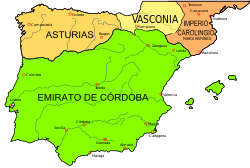
تشكلت مملكة نفاره عندما انتخب أو اعلن زعيم الباسك المحلي íñigo arista ملكا في بامبلونا (تقليديا في 824) وقاد ثورة ضد السلطة الاقليمية الفرنكية
تم استيعاب الجزء الجنوبي من مملكة نافارا من جانب مملكة كاستيا في 1513 وبالتالي اصبحت جزءا من مملكة اسبانيا الموحدة. الجزء الشمالي من المملكه ظل مستقلا ، ولكن انضم مع فرنسا في اتحاد في 1589 عندماورث الملك هنري الثالث من نافارا حكم العرش الفرنسي كهنري الرابع من فرنسا ، و في 1620 دمج الجزء الشمالي من المملكه مع مملكة فرنسا.
مملكة أراگون
كانت مملكة أراجون في الاصل الاقطاعي مقاطعة فرنكيه حول مدينة jaca ، التي كانت متحدة مع مملكة بامبلونا (مملكة نافارا لاحقا) في 925. . تم تقسيم مملكه اراجون من مملكة نافارا في 1035 ، وارتقى بها إلى المملكه راميرو الاول.
نڤاره في العصور الوسطى
الحكم من قِبل شامپين وفرنسا

آل بوربون
آل بوربون ، عائلة ملكية أوروبية مهمة ، و هي فرع من سلالة الكابيتيون . ملكت عائلة بوربون أولا مملكة نافارا و فرنسا في القرن السادس عشر . بحلول القرن الثامن عشر ، حكم أعضاء من سلالة بوربون أيضا عروشا في أسبانيا و نابولي و صقلية ، و بارما. و حاليا إسبانيا و السويد لديها ملوك من سلالة بوربون .
حكم ملوك بوربون نافارا (من عام 1555) و فرنسا (من عام 1589) حتى 1792 بالإطاحة بالنظام الملكي في أثناء الثورة الفرنسية . استعادوها لمدة قصيرة في عام 1814 و بصفة حاسمة في عام 1815 بعد سقوط الإمبراطورية الفرنسية الأولى ، و أطيح بها في ثورة يوليو 1830 . ثم حكم فرع أورليان من العائلة 18 عاما (1830-1848) حتى انه اطاح ايضا. أمراء كوندي كانوا فرعا من البوربون فندومي (Bourbon-Vendômes) و الذين ينتمي إليهم أيضا أمراء كونتي (البوربون - conti). و كل هذه الخطوط انقرضت أوائل القرن التاسع عشر .
فيليب الخامس ملك إسبانيا كان أول حاكم من بوربون لاسبانيا ، في الفترة من 1700. - أطيح بالبوربونيين الأسبان و عادوا عدة مرات ، في الفترات 1700-1808 ، 1813-1868 ، 1875-1931 ، و1975 إلى يومنا هذا.
Spanish conquest

التاج والمملكة: تأسيس دستوري

رموز تاريخية
Coat of Arms of the Kingdom of Navarre during Sancho VI of Navarre
Sign of Sancho VII of Navarre
See also
- Chartered Community of Navarre (modern)
- List of Navarrese monarchs
- Kings of Navarre family tree
- Court officials of the Kingdom of Navarre
- Basque Country (historical territory)
- Basque and Pyrenean Fueros
- History of the Basque people
- Vascones
Historic languages of the Kingdom of Navarre (824–1841):
- Basque, natural language in most of the realm except for the southern plains (Ribera), 824–1841
- Navarro-Aragonese, natural language along the Ebro, in the south-east, some boroughs, and status language, 10–15th century
- Occitan, natural language in some boroughs, status language, 11–14th century
- Castilian language, natural language in southern and increasingly central areas and many urban centres substituting Basque, status language, 15th century-1841
- Gascon, written language in Lower Navarre and limited geographical and social contexts, 1305–1790
- Arabic, language of the Muslim communities remaining in southern areas after the conquest of Tudela in 1118, as well as Muslim liturgy language, 824–14th century and 824–early 16th century respectively
- French, status language increasingly replacing Gascon (Béarnese) in administration and politics, 1624–1790
- Erromintxela, language used by the native Romani communities especially in hilly areas, 15th century-1841
- Hebrew, religious and written language in Jewish communities located in certain urban centres, 10th century-1512
- Latin, Christian Catholic liturgy language and formal language in written scripts increasingly replaced by other Romance languages, 824–1841
مراجع
- ^ أ ب ت Estibaliz Amorrortu, Basque Sociolinguistics: Language, Society, and Culture, (University of Nevada Press, 2003), 14 note5.
- ^ R. L. Trask, The History of Basque, (Routledge, 2014), 427.
- ^ Harvey, L.P. (1996). Muslims in Spain, 1500 to 1614. Chicago: Chicago University Press. pp. 124–125. ISBN 978-0-226-31964-3.
- ^ Jurio, Jimeno (1995). Historia de Pamplona y de sus Lenguas. Tafalla: Txalaparta. pp. 82, 138, 175–177. ISBN 84-8136-017-1.
- ^ Harvey, L.P. (1996). Muslims in Spain, 1500 to 1614. Chicago: Chicago University Press. p. 125. ISBN 978-0-226-31964-3.
- ^ Ciervide Martinena, Ricardo Javier (1980). "Toponimia navarra: historia y lengua". Fontes Linguae Vasconum (34): 90, 91, 102. Retrieved 2016-10-30.
- ^ أ ب Reilly, Bernard F. (1993). The Medieval Spains (in الإنجليزية). Cambridge University Press. p. 139. ISBN 9780521397414. Retrieved 11 October 2019.
The new kingdom of Castile had roughly tripled in size to some 335,000 square kilometers by 1300 but, at the same time, its population had increased by the same factor, from one to three millions [...] Little Navarre with its area of only 10,000 square kilometers and some 100,000 people still had a Muslim minority of about 10,000.
- ^ Middleton, John (2015-06-01). World Monarchies and Dynasties (in الإنجليزية). Routledge. ISBN 978-1-317-45158-7.
- ^ "Kingdom of Navarre | Facts & History". Encyclopedia Britannica (in الإنجليزية). Retrieved 2020-04-10.
- ^ NA, NA (2016-04-30). Medieval Queenship (in الإنجليزية). Springer. ISBN 978-1-137-08859-8.
- ^ Trask, Robert.L. (1996). The History of Basque. New York: Routledge. p. 427. ISBN 0-415-13116-2.
- ^ Collins, R. 1989, p. 159
External links
- Medieval History of Navarre Genealogy
- Pages using gadget WikiMiniAtlas
- Short description is different from Wikidata
- Articles containing باسكية-language text
- Articles containing إسپانية-language text
- Articles containing فرنسية-language text
- Articles containing لاتينية-language text
- Pages using Lang-xx templates
- Articles containing إنگليزية-language text
- Articles with hatnote templates targeting a nonexistent page
- Coordinates on Wikidata
- مملكة نڤاره
- تاريخ الباسك
- دول سابقة في شبه جزيرة أيبيريا
- ممالك سابقة
- ملكيات سابقة في أوروپا
- Medieval Spain
- عصر النهضة الاسباني
- Early Modern history of Spain
- دول وأقاليم تأسست في عقد 820
- دول وأقاليم انحلت في 1841
- تأسيسات 824
- تأسيسات القرن التاسع في اسبانيا
- انحلالات 1841 في اسبانيا
- تاريخ إسپانيا
- ممالك اسبانيا


